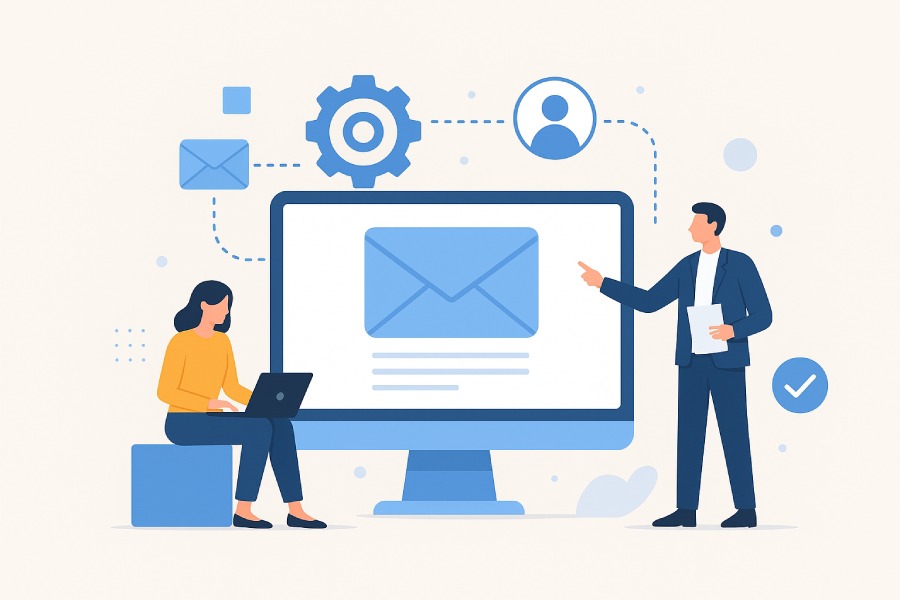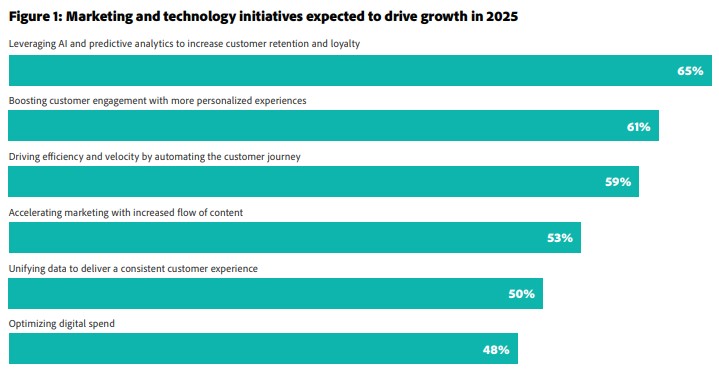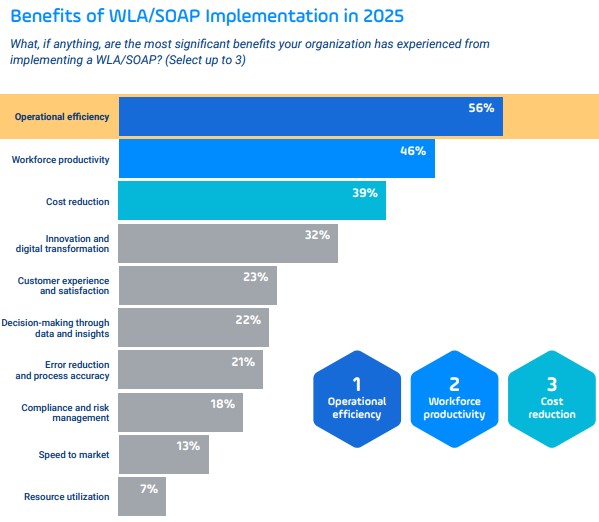When I first started managing email campaigns, I spent hours crafting individual messages, manually segmenting lists, and tracking responses. This process was no walk in the park and left little to no room for strategic planning.
Amid this chaos, I learned the role of automation in a scalable email strategy, and it changed everything for me.
In fact, leveraging automation tools, including artificial intelligence, is the top initiative expected to drive growth in 2025.
Image via Adobe
Automation streamlines repetitive tasks, letting you focus on building meaningful relationships with your audience.
In this post, I’ll discuss the role of automation in a scalable email strategy and how it can transform your campaigns without losing the personal touch.
Let’s get started.
Why Email Automation Matters
Before we explore the role of automation in a scalable email strategy, let’s discuss why automation is a game-changer for email marketing. Studies show that email marketing is one of the top areas where marketers and business owners invest in automation, and it’s easy to see why.
Image via Ascend2
Automation tools handle repetitive tasks, such as sending welcome emails, following up on abandoned carts, or scheduling newsletters. Instead of managing everything manually, you can automatically build smart workflows that respond to customer behavior.
The result? You spend less time on execution and more time for planning, testing, and improving performance.
What Is the Role of Automation in a Scalable Email Strategy?
One thing I’ve come to appreciate is how automation has streamlined my email marketing efforts. It has become such a huge part of my entire marketing strategy, not just email.
Having said that, here’s the role of automation in a scalable email strategy.
1. Reducing Costs and Boosting Efficiency
As your email list grows, manually managing tasks like segmentation, scheduling, and follow-ups quickly becomes overwhelming, not to mention expensive. For many marketers, the instinctive next step is to hire a personal assistant or outsource routine work just to stay afloat. But that’s not always sustainable or cost-effective.
This is where the role of automation in a scalable email strategy truly shines. It enables you to do more with less. In fact, recent studies show that boosting operational efficiency is the top use of automation.
Image via HubSpot
Automation streamlines repetitive, time-consuming tasks such as list updates, behavioral triggers, and email sequencing. The role of automation in a scalable email strategy goes beyond time savings. It also ensures greater accuracy and consistency.
It eliminates costly errors, like sending campaigns to the wrong segment or missing crucial follow-ups, which can erode both customer trust and ROI.
2. Optimizing Content to Boost Engagement
As your email list grows, manually optimizing content becomes unmanageable. Another role of automation in a scalable email strategy is to ensure that each message, whether it’s the subject line or CTA, is optimized.
If you want people to actually engage with your emails, the content has to match their interests and timing. As you know, every part of your email is important, whether it’s the subject line, CTAs, or email body.
Crafting all these by hand and ensuring they capture attention is a time-consuming and challenging process. Plus, optimizing them poorly risks low open rates and weak audience connections.
As Attrock expert says, automated email tracking tools can help improve your email performance. They track the performance of your email campaigns and provide data that increases email productivity.
Beyond performance, another role of automation in a scalable email strategy is refining your email content to drive engagement.
Additionally, an AI tool like an Adobe Certificate Creator can create certificates promptly to include in your email copy, thereby boosting the authenticity of your emails.
Rather than spending hours rewriting the same email for multiple segments, automation handles the variations. This enables you to maintain high engagement levels even as your list grows.
3. Delivering Personalized Experiences
Nobody wants irrelevant emails cluttering their inbox. In fact, 71% of customers feel frustrated when messages feel irrelevant or out of touch, and 81% simply ignore them. It’s no wonder more marketers are investing in personalization.
Image via Moengage
By automatically segmenting your audience based on behavior, preferences, or demographics, you can deliver tailored content at scale. This is something that’s nearly impossible to manage manually as your list grows.
Whether you’re welcoming a new subscriber or re-engaging a long-time customer, automation ensures every email feels personal and relevant.
The role of automation in a scalable email strategy is to eliminate the need for manual list sorting or creating dozens of one-off messages. This helps save time while maintaining a high level of quality across your entire campaign.
Furthermore, automation enables real-time engagement. By using predefined rules, your system can instantly respond to actions like website visits, product views, or cart abandonment within minutes. No manual intervention needed.
Ultimately, the role of automation in a scalable email strategy is to make personalization not only possible but also repeatable and sustainable, regardless of the size of your audience.
4. Expanding Reach Without Sacrificing Quality
Scaling your email strategy means reaching a wider audience while maintaining consistency and quality. However, it’s easy to lose the quality of your emails as you scale.
There is a risk of generic messaging, inconsistent delivery, and resource strain. Scaling manually can significantly increase this risk! Automation enables you to send emails to thousands or even millions of subscribers with minimal effort.
Automation platforms boost deliverability, helping your emails land in inboxes, not spam folders. The role of automation in a scalable email strategy is to maximize your reach without compromising personalization.
Every single message you send, whether a newsletter, promotional, or transactional email, automation ensures it’s timely and relevant. Additionally, it streamlines campaign management across different time zones.
The role of automation in a scalable email strategy is to help you grow your audience without losing the quality that builds trust and drives engagement.
5. Improving Retention with Smart Workflows
Acquiring new subscribers is costly, but keeping your existing audience engaged becomes even more important as your email list grows.
The role of automation in a scalable email strategy is to simplify this complexity by improving retention with smart workflows.
Manually managing retention at scale can lead to inconsistent communication, irrelevant content, and missed opportunities to reconnect. Subscribers can quickly lose interest and churn.
You can schedule personalized updates according to these changelog examples, following a product release, or use automated triggers to re-engage inactive users.
By leveraging smart workflows, you can maintain steady engagement and keep your brand top of mind, regardless of how large your subscriber base becomes.
6. Monitoring and Enhancing Performance
Managing a growing email program means juggling a multitude of data points, including open rates, click-through rates, unsubscribes, and more. Doing this manually is inefficient and borderline chaotic.
Automation tools provide real-time insights and take immediate action when needed. For example, they can:
- Pause underperforming campaigns
- Alert you to deliverability issues
- Adjust send frequency based on engagement trends
These insights also show you how your scaling email strategy is consuming resources. If you don’t like the results, you can refine your strategy so every campaign performs better than the last.
The role of automation in a scalable email strategy ensures your campaigns stay responsive and effective, even as your audience continues to grow.
7. Streamlining Onboarding and Lead Nurturing
A strong first impression and consistent follow-up are essential to turning new subscribers into loyal customers. But as your email list grows, managing onboarding and nurturing manually becomes chaotic and nearly impossible to maintain at scale.
This is where the role of automation in a scalable email strategy becomes critical to providing a seamless onboarding experience.
Automation ensures every new subscriber receives timely, personalized welcome emails or onboarding tooltips that set the tone for your relationship. These deliver key information, such as introducing your brand, products, and value.
With automation, you can also nurture long-term engagement. Drip campaigns, for example, guide leads through your sales funnel with carefully timed messages based on behavior or activity. These can work together with your LinkedIn lead generation efforts to create a more complete outreach strategy.
Instead of manually tracking each step, you can send automated follow-up emails and post-purchase confirmations to ensure that no lead slips through the cracks.
You can also set up dynamic workflows that adjust based on each subscriber’s actions. This could be opening an email, clicking a link, or visiting a product page.
Ultimately, the role of automation in a scalable email strategy isn’t just about sending more emails. Every message should feel intentional and relevant, even at scale. This consistency builds trust and keeps subscribers engaged from day one.
8. Testing and Refining Continuously
Running email campaigns without testing is like guessing in the dark. As your audience grows, so does the need to refine what works, and automation makes that scalable.
One of the core roles of automation in a scalable email strategy is to optimize and pinpoint which email elements drive the best results. For starters, automation simplifies A/B testing by letting you compare subject lines, CTAs, or designs with minimal effort.
For example, a recent report found that non-personalized subject lines had a 41.87% open rate compared to 35.78% for personalized ones. This is an insight gained through testing.
Beyond testing, automation tools enable you to segment your audience, analyze performance, and adapt in real time. This helps maintain high engagement as you scale.
Simply put, the role of automation in a scalable email strategy is to keep your optimization process running smoothly while your reach continues to grow.
Best Practices for Implementing Email Automation
Now that you know the role of automation in a scalable email strategy, let’s talk about how to do it right. While automation is powerful, you still need a clear plan to avoid sending generic or irrelevant messages.
Secure your email campaigns with SPF, DKIM, and DMARC for trusted, hassle-free delivery.
As you build your automation workflows, maintaining secure email communication is just as important as delivering the right message. Here are some best practices to guide your strategy as you scale:
Select a Feature-Rich Automation System
Considering the role of automation in a scalable email strategy, you can’t afford not to use the right tools. Choose an automation system with advanced capabilities like audience segmentation, testing options, and reliable delivery to ensure your campaigns run smoothly.
With a modern, robust system, you can create targeted email flows, such as welcome sequences or re-engagement campaigns, without manual setup. It also ensures your emails consistently reach subscribers’ inboxes, boosting trust and engagement.
Set Up Clear Automation Triggers
What specific user actions do you have in mind to trigger automated emails instantly? Is it signing up, clicking a link, completing a purchase, or submitting a form?
Whatever action you take, be specific about it to ensure your automation system responds accurately to user behavior without requiring manual oversight.
Map out each trigger’s conditions carefully to avoid sending irrelevant messages, such as ensuring only new subscribers receive welcome emails. It’s also essential to test triggers regularly to confirm they fire correctly, preventing delays or missed emails.
Create Structured Email Workflows
Build organized email sequences, like onboarding or re-engagement flows, to guide subscribers through your automation system.
Design each workflow with clear steps, such as a welcome email followed by a tutorial email after two days, to maintain consistency.
Consider using visual workflow editors to easily monitor and adjust sequences, enabling you to identify and address issues before they impact subscribers.
Automate Regular System Maintenance
To keep your system healthy, schedule automated checks to clean your subscriber lists by removing inactive or bounced emails. However, before you do, set up automatic backups of your automation data to prevent loss in the event of technical issues.
You can also automate regular maintenance tasks, like updating trigger conditions or workflow templates, to reduce manual work.
Monitor Automation Performance Metrics
Track automation-specific metrics, like trigger response times or workflow completion rates, to measure system efficiency. For example, slow trigger responses might indicate a need to adjust server settings or simplify workflows.
Use automated alerts to notify you of issues, such as failed email sends or broken triggers, so that you can fix them quickly.
Conclusion
With how fast email marketing keeps evolving, understanding the role of automation in a scalable email strategy is what helps you stay ahead. It enables you to grow your campaigns and your business without adding chaos to your daily workflow.
I can’t emphasize enough the vital role of automation and robust email security in a scalable email strategy. Honestly, it’s been a total game-changer for me. If you haven’t started using automation yet, now’s the perfect time.
Try out a few demos, test some free trials, and see for yourself how powerful these tools can be. So, take control of your email marketing and don’t let manual processes hold you back any longer.




